Make katsuo dashi with bonito flakes in 15 minutes! This easy bonito dashi recipe brings deep umami flavor with just a few simple steps.
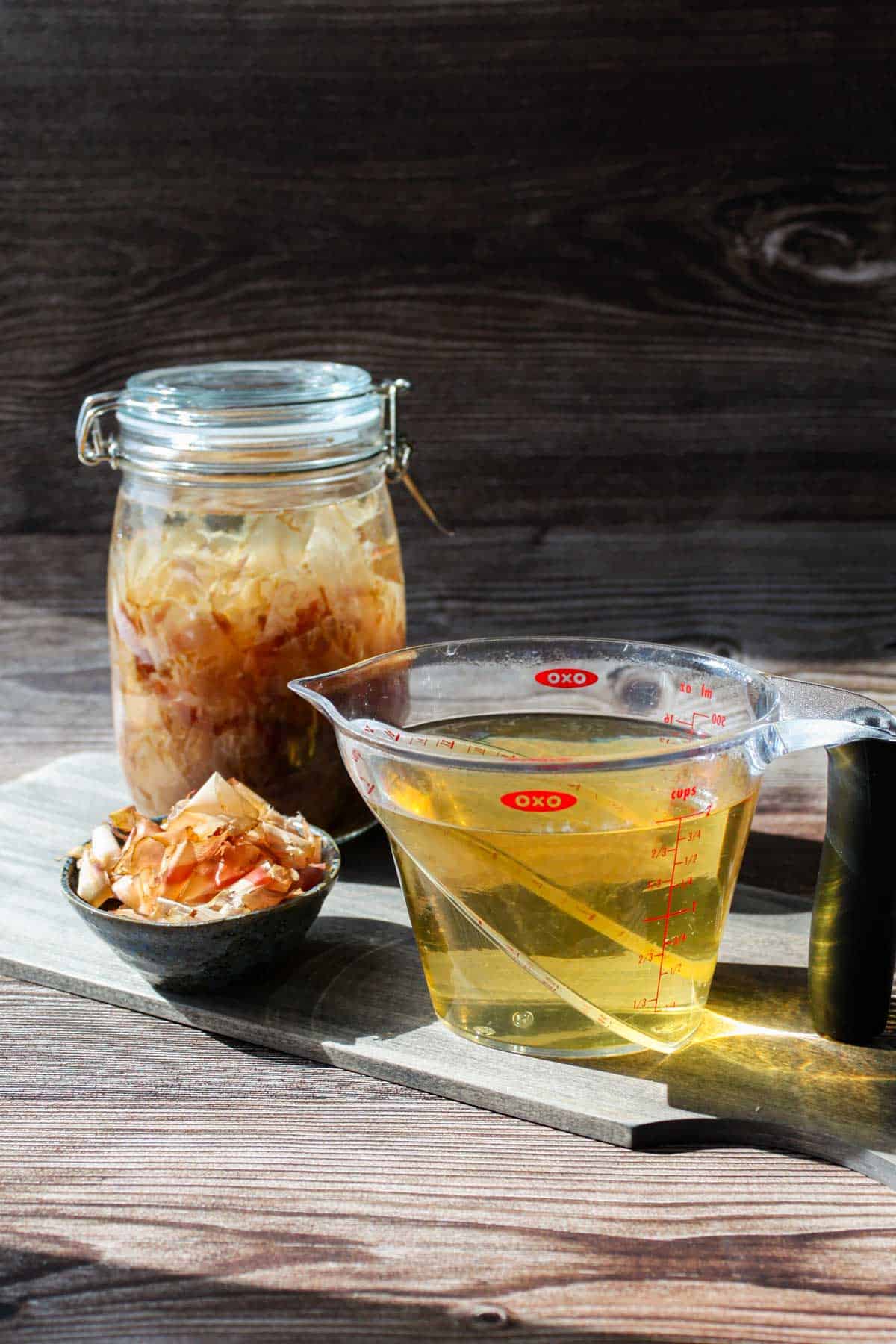
Katsuo dashi is one of my favorite types of dashi. It has a rich, elegant flavor and a beautiful golden color, deep but not overpowering. Just the aroma makes me feel like I’m doing something kind for myself 🙂
In this post, I’ll show you two easy ways to make katsuo dashi, so you can choose the method that best fits your lifestyle.
You can use this flavorful bonito dashi to make classics like miso soup, nimono (simmered dishes), or you can also learn the basics of dashi and use katsuo dashi as a base to build your own kombu and bonito dashi blend.
Jump to:
- Why You'll Love This Recipe
- Notes on Ingredients
- Substitutions and Variations
- How to Adjust Katsuo-to-Water Ratio (by weight)
- How to Make Katsuo Dashi
- Reusing Dashi Ingredients
- Kurumi's Tips
- How to Use Katsuo Dashi
- Storage Instructions
- FAQs
- Explore Other Types of Dashi
- 📖Recipe
- 🎁FREE Dashi Cheat Sheet
- 📌Pin This Recipe For Later!
Why You'll Love This Recipe
- Stress-free and sustainable: I’ll show you two easy ways to make katsuo dashi, so you can choose the method that best fits your lifestyle.
- Science-backed but doable: I’ve explored the best techniques to draw out maximum umami (hello, fellow cooking science nerds! 🙋♀️), then simplified them so you can make it at home. No fancy tools required!
- Super flexible: I’ll show you how to adjust the ratio of ingredients to water so your dashi is just right for whatever you’re making, whether it’s miso soup, mentsuyu, or anything in between.
Notes on Ingredients
See the recipe card for the full ingredients list.
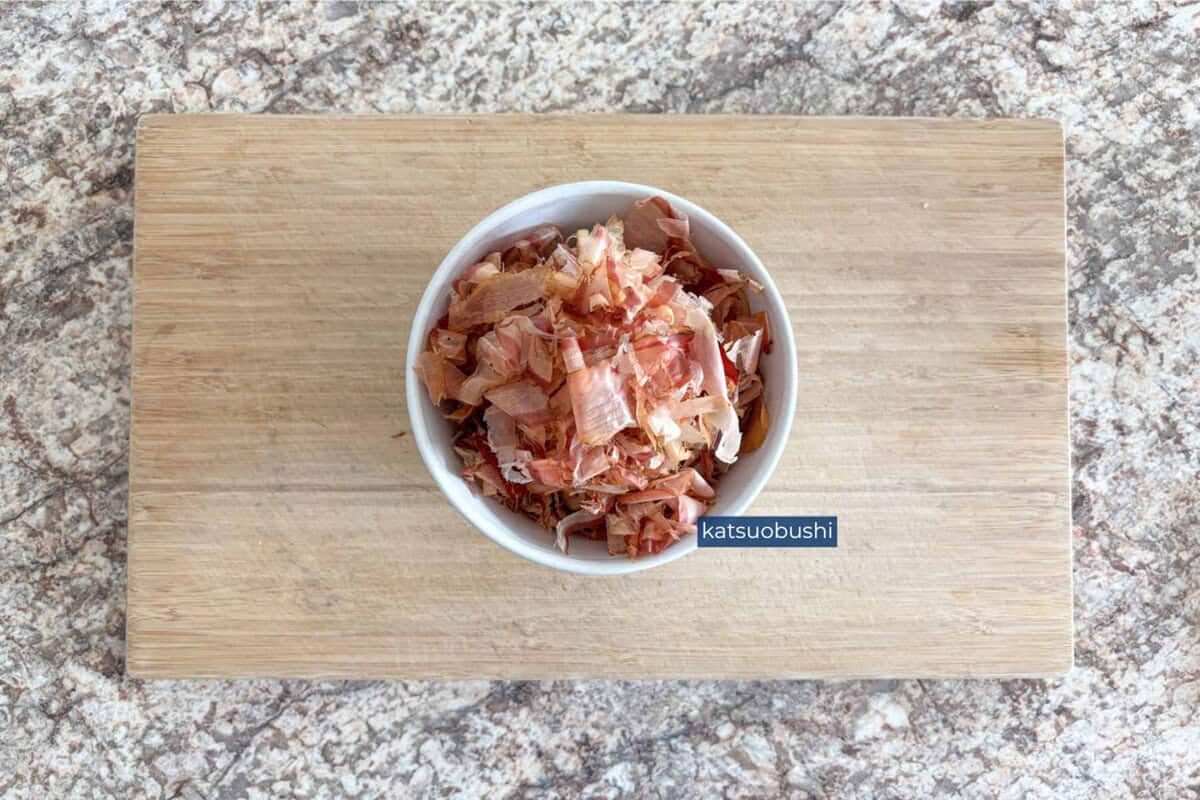
Katsuobushi (Dried Bonito Flakes)
Not all bonito flakes are created equal! The type you use can change both the flavor and how you use the dashi.
- Usu-kezuri (薄削り) – Thin shavings: the most common type, perfect for everyday cooking. Quick to infuse flavor and gentle on the aroma, great balance of umami and aroma.
- Chiai-nuki (血合抜き) – Bloodline removed: a cleaner, lighter flavor. Good for those who want a more refined or delicate dashi.
- Atsu-kezuri (厚削り) – Thick shavings: these take longer to simmer but produce a deeper, richer broth. Great for recipes that need a bolder base.
✨ My tip: For most home cooks, thin shavings (usu-kezuri) are the best all-around choice. Avoid the ultra-fine, fluffy flakes meant for topping okonomiyaki or takoyaki as they’re too delicate for broth-making.
I personally recommend something like Kaneso Hanakatsuo or a similar standard-grade bonito flake from a trusted brand.
Water
Yes, even water has a say in your dashi’s flavor. Here's what to know:
- Soft water helps extract umami compounds (like inosinate) from bonito flakes more efficiently.
- Hard water (like much of the U.S. tap water) can make your broth taste dull, cloudy, or even slightly bitter.
👉 If you’re in the U.S., using filtered water (like from a Brita pitcher) makes a big difference, and it’s way more sustainable than buying bottled water.
💡You can find these ingredients at Japanese or Asian grocery stores, or online at Amazon or Weee!
Substitutions and Variations
- Can’t use katsuobushi (bonito flakes)?: No problem! You can still enjoy delicious Japanese dashi with other options:
- Niboshi dashi (made with dried anchovies) brings a deeper, slightly more savory flavor.
- Awase dashi (a blend of kombu and another ingredient like shiitake or niboshi) is versatile and layered.
- Vegan-friendly alternatives like vegan dashi, kombu dashi, or shiitake dashi offer gentle, plant-based umami.
- Need a shortcut?: If you’re short on time or forgot to soak your ingredients, instant dashi powder can save the day. While it won’t have the depth of homemade dashi, it’s convenient for quick miso soup or last-minute recipes. (Tip: Choose additive-free versions when possible.)
- Vegan or Vegetarian?: Katsuo dashi is fish-based, but you can still enjoy a rich broth with vegan dashi options:
How to Adjust Katsuo-to-Water Ratio (by weight)
You can adjust the amount of bonito flakes depending on how you plan to use the dashi.
| Ratio | Best For | Notes |
|---|---|---|
| 4% | Dishes that highlight dashi, like suimono and chawanmushi | Rich and flavorful stock often used in Kyoto-style fine dining |
| 3% | My recommendation | This works well when cooking outside Japan because it's harder to find soft water and high-quality dashi ingredients. |
| 2% | Everyday home cooking | Light, balanced flavor that doesn’t overpower other ingredients |
For example, if you're using 1 liter of water, a 3% ratio means using 30 grams of bonito flakes.
How to Make Katsuo Dashi
You can make katsuo dashi two different ways, depending on your schedule and how hands-on you want to be.
Option 1: Cold Brew Method (Overnight)
Best for prepping ahead, no cooking required!
- Add bonito flakes to a container of water.
- Let it sit in the fridge for 8 to 24 hours.
- Strain out the bonito flakes.
💡 Tip: Use a reusable teabag or infuser to make straining even easier!
💡Check out my cold brew dashi guide for more details!
Option 2: Stovetop Method (Quick)
The fastest method, ready in minutes!
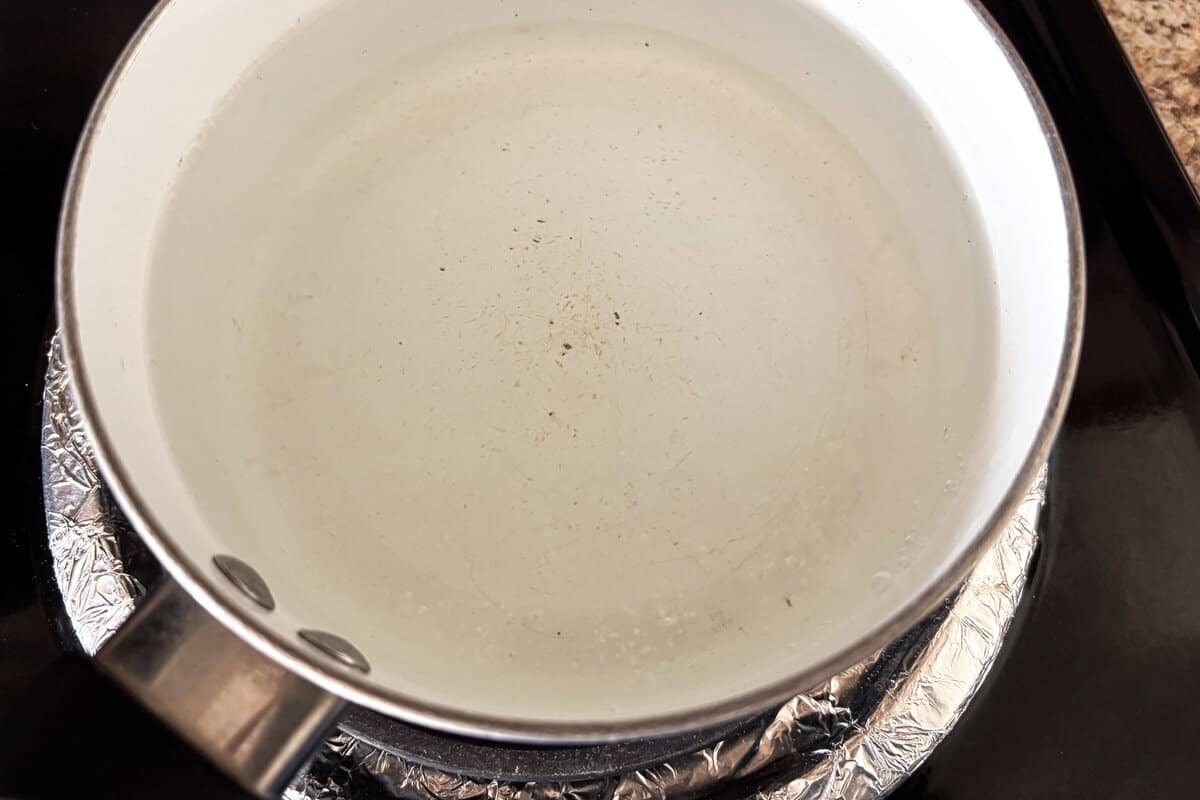
Step 1: Add water to a pot and heat until small bubbles start rising (don’t boil).
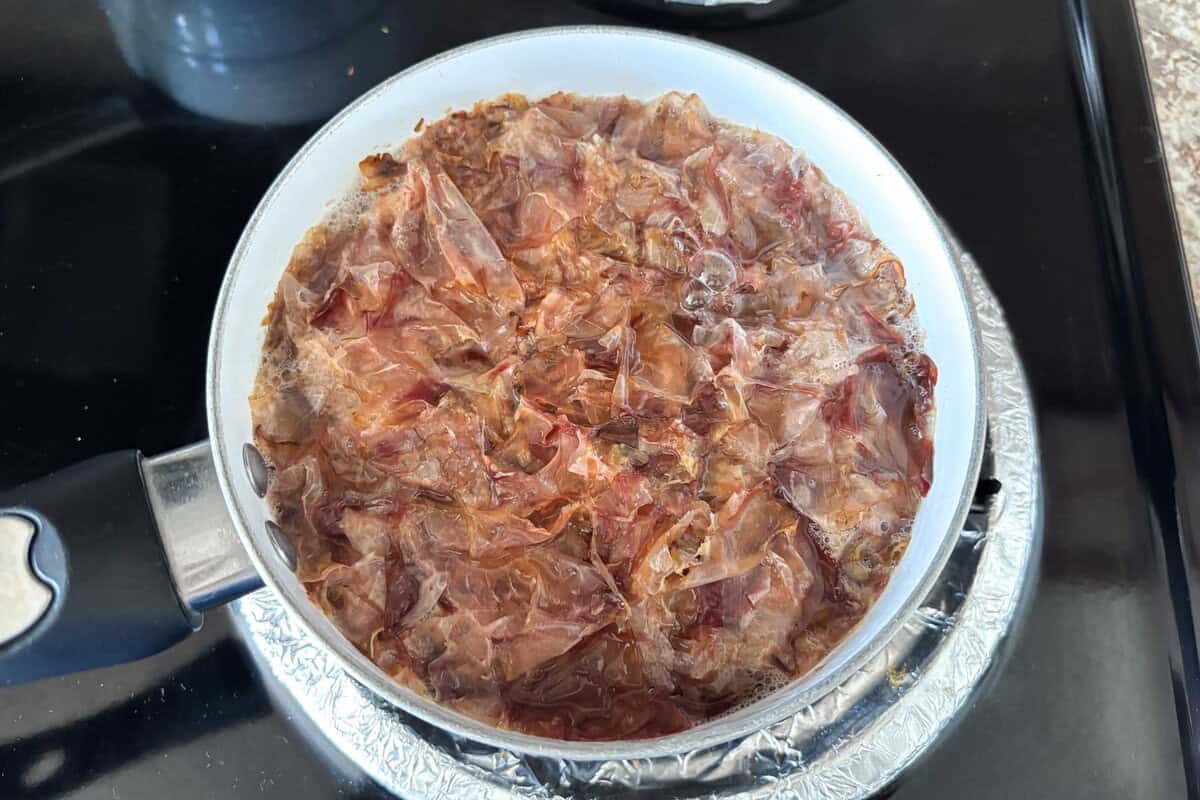
Step 2: Turn off the heat and add katsuobushi. Let it steep for 1 to 2 minutes.
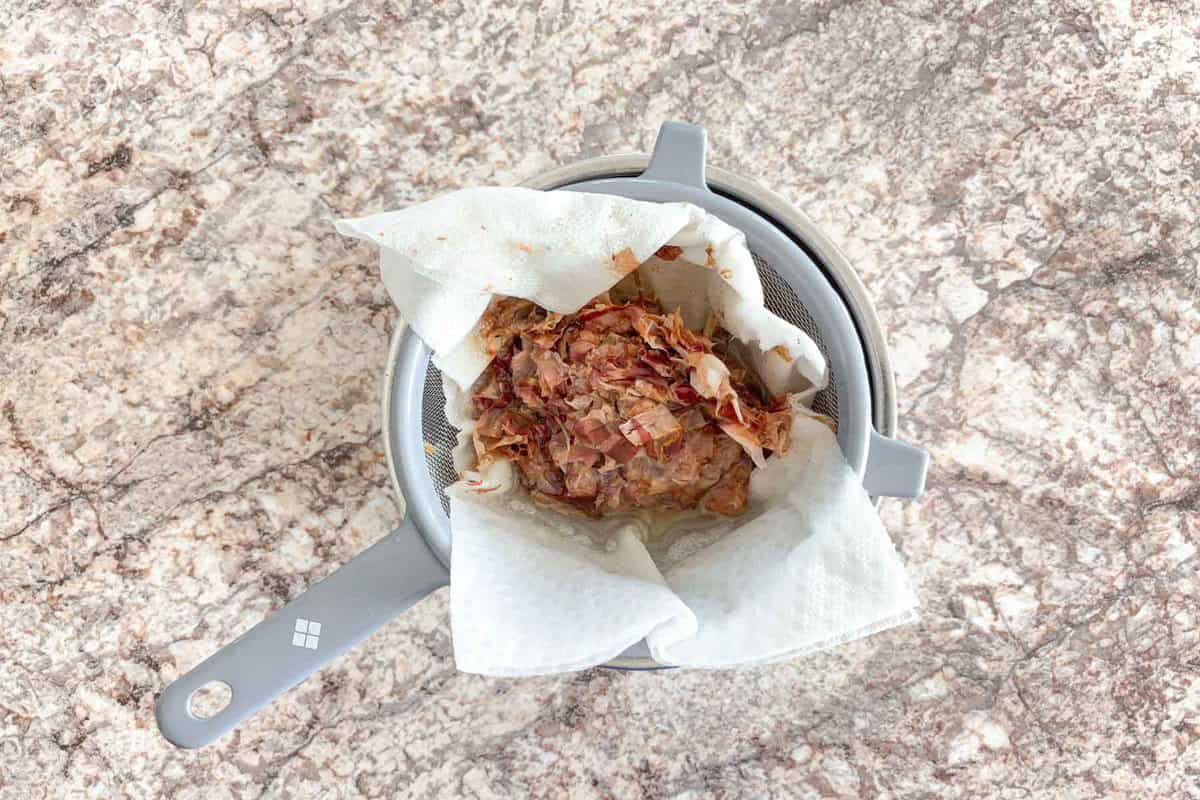
Step 3: Strain through a colander lined with paper towel or a fine mesh strainer.
🚫 Don’t squeeze the katsuobushi, just let them drain naturally.
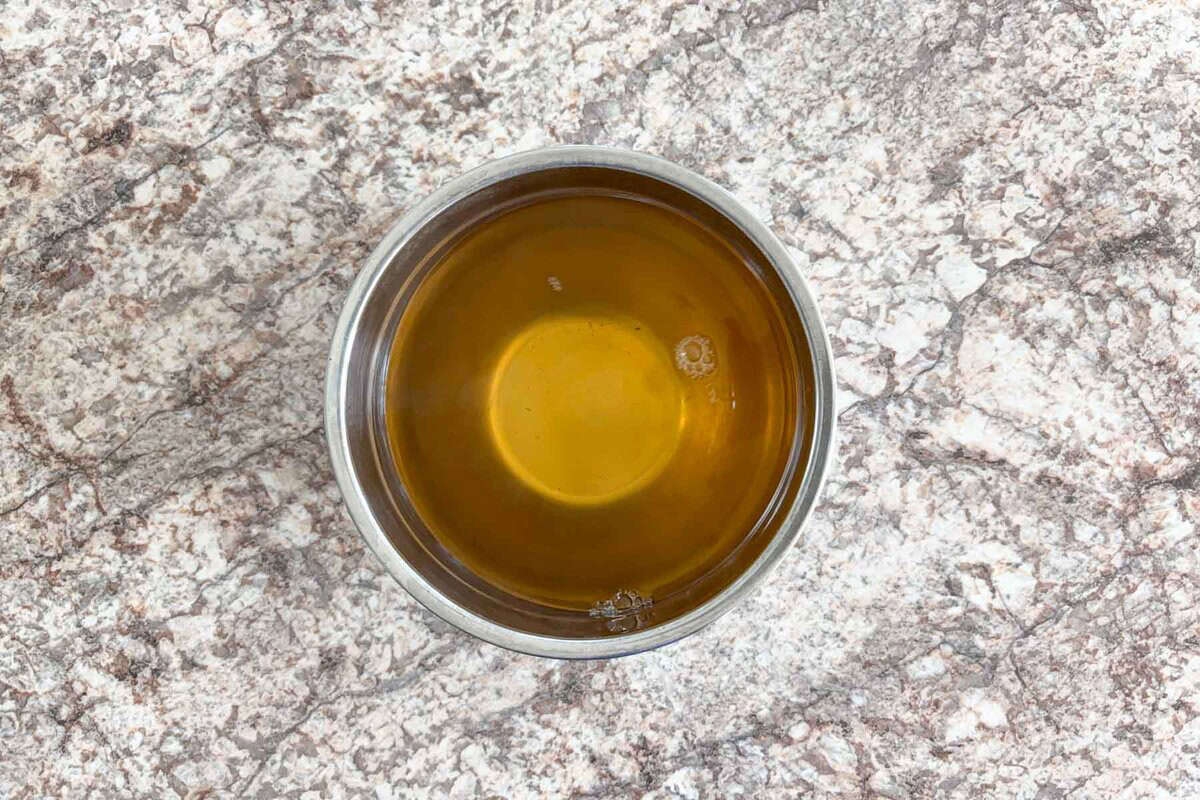
Step 4: Done! Enjoy the delicious dashi!
Niban Dashi (Second Brew – Optional)
Make a second, lighter batch of dashi using the used katsuobushi:
- Add the used flakes and 2 cups of water to a pot.
- Bring to a boil, then simmer for 3 to 5 minutes.
- Turn off the heat and add 5g of fresh bonito flakes.
- Let steep for 1 to 2 minutes, then strain. This time, go ahead and squeeze the flakes to extract every drop!
Reusing Dashi Ingredients
Don’t toss your used bonito flakes! Even after making niban dashi, they’ve still got life (and flavor) in them. Here are a few easy, delicious ways to give them a second purpose:
- Furikake: Chop the leftover katsuobushi into small pieces and dry-sauté in a pan. Add a splash of soy sauce and mirin, then sprinkle over rice or veggies for an instant umami upgrade.
- Okaka (Onigiri Filling): Mix the seasoned flakes with soy sauce to make okaka, a classic rice ball (onigiri) filling. It’s salty, savory, and nostalgic all at once.
- Dashi Ponzu: Steep the used flakes in ponzu sauce to infuse it with even more umami. Try drizzling it over grilled salmon, tofu, or roasted veggies.
- Dashi Soy Sauce (Dashi Shoyu): Soak the leftover flakes in soy sauce to create a versatile seasoning for stir-fries, rice, cold noodles, or even tamagoyaki.
💡 Store your used katsuobushi in an airtight container in the fridge and use within a few days. Or freeze for longer storage!
Kurumi's Tips
- Watch the pot closely: Temperature is everything when making dashi. Bonito flakes release the best flavor around 85°C (185°F), right before boiling. You’ll know it’s ready when small bubbles begin rising from the bottom to the surface. Never let it come to a full boil, or you’ll risk cloudy, bitter broth.
- Don’t wait for bonito flakes to sink: A common myth! Letting the flakes sit until they sink actually cools the water too much, and that can lead to an unbalanced, overly fishy taste. As Chef Hiromitsu Nozaki explains in his book The Delicious Principles According to Hiromitsu Nozaki (野崎洋光が考える 美味しい法則, p. 42), modern bonito flakes often don’t sink well because they’re machine-shaved and thinner than the traditional hand-shaved ones. So don’t worry if they float, just steep for the right time and strain.
- No stirring or squeezing: Let the flakes gently steep, don’t stir, and definitely don’t squeeze them when straining (except when you’re making nibandashi). That can release bitter compounds and make your dashi cloudy or too fishy. Just let gravity do the work!
- Make it your own: There’s no single “correct” way to make dashi. Feel free to tweak the ingredients or steeping time to match your taste and how you’ll use it. For ideas, check the section on How to Adjust Dashi Based on How You’ll Use It.
How to Use Katsuo Dashi
Katsuo dashi has a rich, elegant umami with a noticeable but clean fish flavor. It works beautifully in dishes that either do or don’t include other umami-rich ingredients. It holds its own and brings depth to everything it touches.
Here are a few popular ways to use it:
- Miso Soup: A comforting everyday staple. Katsuo dashi adds warmth and depth to even the simplest version.
- Oden: This cozy, simmered one-pot dish becomes extra satisfying with katsuo dashi as the base.
- Dashimaki Tamago: Fluffy rolled omelet with a delicate, savory flavor, perfect for bento or breakfast.
💡 Pro tip: If you're looking for a longer-lasting, more balanced dashi, try awase dashi instead. It blends kombu and katsuobushi for a more rounded, mellow flavor.
Storage Instructions
- Dashi: Store in an airtight container for up to 3 days in the fridge or 2 weeks in the freezer (ice cubes work great for small portions).
- Used bonito flakes: Pat dry and store in an airtight container for up to 1 week in the fridge or 1 month in the freezer.
FAQs
Store a big bag of katsuobushi in the fridge, tightly sealed to keep out air. If the bag has a zipper, press out the air before sealing. If not, use a clip or rubber band. Use within 2 to 4 weeks after opening to maintain the best flavor and aroma.
Explore Other Types of Dashi
Katsuo dashi is just one delicious option in the world of Japanese soup stocks—each type has its own personality and best uses, depending on what you're making and how you want it to taste.
If you’re curious about the differences or not sure which dashi to use when, check out my Ultimate Guide to Dashi, where I break down each variety, what they’re made from, and how to pick the right one for your cooking.
Want to try making more from scratch? Here are a few you might love:
- 🌱 Vegan Dashi: Plant-based, light, and full of gentle umami
- 🍄 Shiitake Dashi: Deep, earthy, and mushroom-rich
- 🌿 Kombu Dashi: Clean, ocean-y, and elegant flavor
- 🐟 Iriko Dashi: Made from dried anchovies with bold, briny flavor
- 🥣 Awase Dashi: A well-rounded, everyday dashi made by combining ingredients
- 🐟 Bonito Dashi (Katsuo Dashi): You’re reading it right now!
🎁Grab your FREE dashi cheat sheet! Stick it on your fridge and skip Googling recipes every time 🙂
💌 If you tried this recipe and liked it, I’d love to hear from you! Leave a comment and review below, or send a photo of your dish to my email. I’d be so happy to see your creation!
📖Recipe
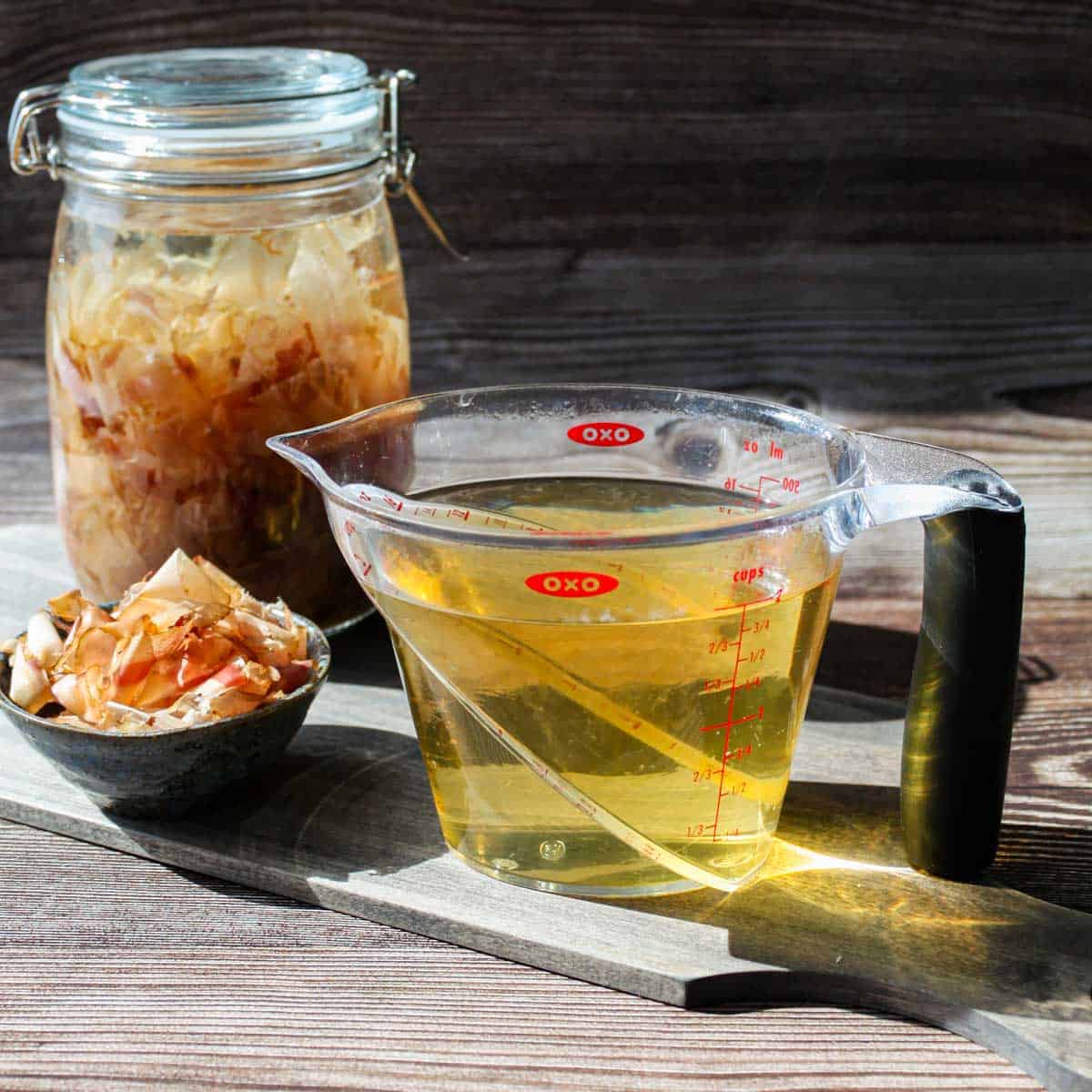
Katsuo Dashi (Easy Bonito Dashi Recipe with Katsuobushi)
Ingredients
Method
- Prep: Add 30 g katsuobushi (bonito flakes) and 4 cups filtered water to a container. Tip: Use a disposable teabag or infuser for easy straining later.
- Refrigerate and Steep: Cover and chill in the fridge for 8 to 24 hours.
- Strain: Strain out the bonito flakes and use your dashi right away or store for later.
- Heat the Water: Pour 4 cups filtered water into a medium pot and heat gently. Stop when small bubbles start rising; do not boil.
- Add and Steep Katsuobushi: Turn off the heat and add 30 g katsuobushi (bonito flakes). Let it steep quietly for 1 to 2 minutes without stirring.
- Strain Carefully: Pour through a fine mesh strainer or paper towel-lined colander. Let the flakes drain naturally, don’t squeeze!
- Start the Second Brew: Add used bonito flakes and 2 cups fresh water to a pot, then bring to a boil.
- Simmer: Lower the heat and simmer for 3 to 5 minutes.
- Add Fresh Katsuobushi: Turn off the heat and add 5g fresh bonito flakes (about ⅓ cup tightly packed).
- Final Steep: Let these fresh flakes steep for 1 to 2 minutes.
- Strain and Extract: Strain the dashi and gently squeeze the flakes this time to get all the flavor out.
Notes
- Water: Soft water extracts more umami. If your tap water is hard (like in many parts of the U.S.), use filtered water (e.g., Brita).
- Katsuobushi (Bonito Flakes): Use thin-shaved flakes (usu-kezuri), like Kaneso Hanakatsuo. Avoid powdery “topping” flakes; they’re not meant for dashi.
- Katsuobushi Ratio (to Water)
- 4% = Strong dashi for clear soups, chawanmushi
- 3% = Balanced flavor, great for cooking outside Japan (recommended)
- 2% = Light dashi for everyday home use
- Reusing Ingredients:
Use spent kombu/katsuobushi for:- Furikake (pan-toast with soy sauce/mirin)
- Okaka (mix with soy sauce for onigiri filling)
- Dashi soy sauce (soak in soy sauce)
- Dashi ponzu (soak in ponzu)
- How to Use Katsuo Dashi: Great for miso soup, oden, dashimaki tamago, or any dish that needs a rich umami base, even simple simmered veggies!
- Storage Instructions:
- Dashi: Store in an airtight container for up to 3 days in the fridge or 2 weeks in the freezer (ice cubes work great for small portions).
- Used Katsuobushi: Pat dry and store in an airtight container for up to 1 week in the fridge or 1 month in the freezer.
🎁FREE Dashi Cheat Sheet
📌Pin This Recipe For Later!
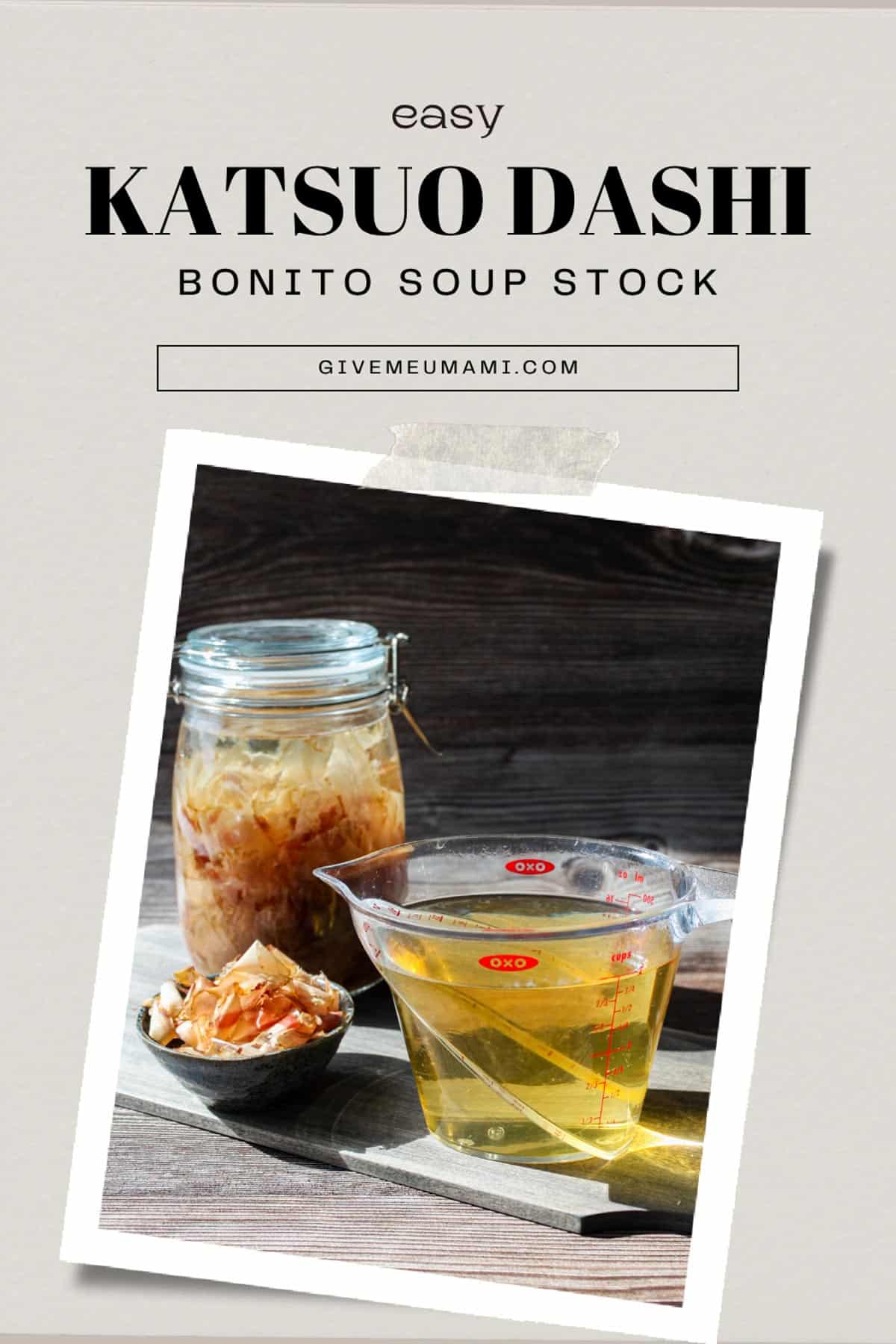

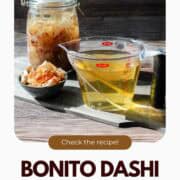
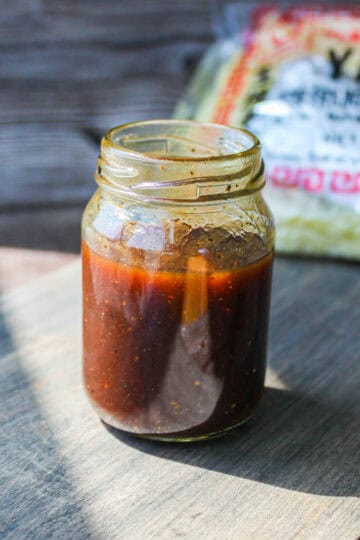

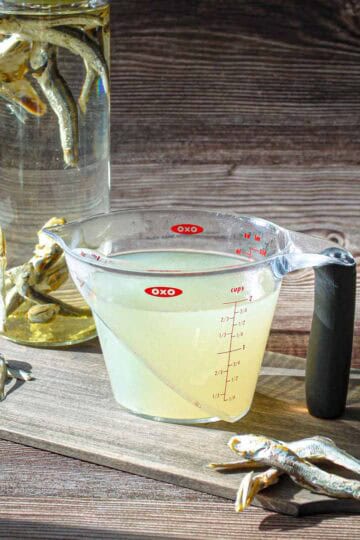
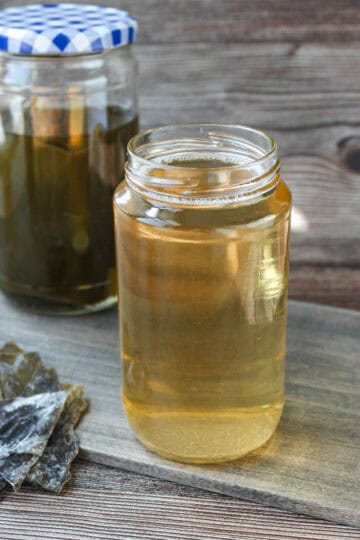
Kurumi says
I like the other types of dashi, but katsuo dashi might be the easiest and most flavorful one you can make in a short time! The best part? It's also easy to reuse the spent katsuobushi. I love chopping them up and soaking them in ponzu. They go really well with grilled salmon. I hope you give this recipe a try and enjoy the yumminess too!